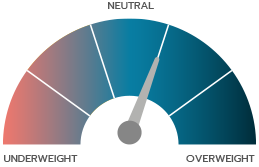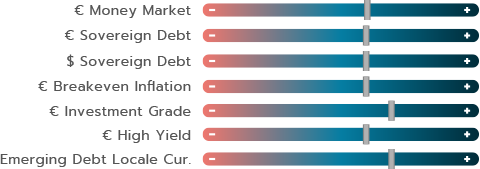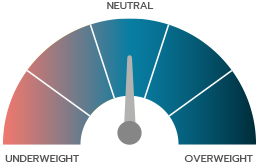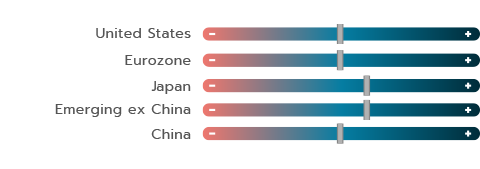PERSPECTIVES
MARKET AND ALLOCATION
Our experts monthly overview
OUR CENTRAL SCENARIO

Deputy Chief Executive Officer,
Chief Investment Officer
OFI INVEST
US inflation and economic activity figures continued to drive the markets in recent weeks, pending more visibility on the Federal Reserve’s timing. After some jitters early in the month, the fixed-income markets were reassured by Jerome Powell’s words and weaker job market figures. It is less the Fed’s timing than its expected trajectory that is weighing on the long section of yield curves. While a third rate cut looks unlikely this year, due in particular to the electoral calendar, we still believe that the Fed will begin a rate-cut cycle this year and will continue it next year. As for the European Central Bank (ECB), a first move appears to be in the cards for June, with a total of three rate cuts by yearend, as long as the Fed acts as we expect it to do in order to prevent a depreciation in the euro that might worry the ECB on the imported inflation front, although such fears look overdone at this point.
On the bond markets, we are sticking to a positive bias on duration at current levels. Any upward surge can be exploited to extend positions, as occurred late last month. We are also remaining exposed to the steepening in curves, based on our expectations of initial moves by central banks.
The credit markets are still our sweet spot, and we once again took note of a inverse phenomenon in which spreads narrowed while yields rose, a sign of the resilience of this asset class. Keep in mind that idiosyncratic risks, which were borne out as we mentioned, had no contagion impact on the markets. Another positive sign is that the primary market remained very busy, particularly in high yield, which accordingly postponed the risks of a refinancing wall for the coming years.
The equity markets suffered a bout of weakness against a backdrop of concerns over short-term interest rates and geopolitical tensions, which led to some convexity positions being closed out, something that we mentioned last month. That being said, the declines do not look pronounced enough for us to switch to a firm overweighting position, given persistent uncertainties. We are therefore sticking to our neutral stance at current levels, while taking a contrarian opportunistic approach, depending on market volatility.
OUR VIEWS AS OF 13/05/2024
In the United States, rate-cut anticipations were pushed back after inflation figures once again exceeded expectations. As of the end of April, the markets were pricing in just a single Fed rate cut in 2024 and barely three by the ECB. US and European bond yields accordingly resumed their upward climb, slightly surpassing our short-term expectations. Against this backdrop, we reiterate our positive view on the bond asset class, as well as our overweighting of duration – an overweighting that we had slightly increased in April by focusing on the short section of the yield curve. We are nonetheless leaving all our cursors unchanged in various bond asset classes, with the exception of emerging market debt, which we are expanding, due mainly to the decoupling of the US economy from other regions.
The equity markets (in the US, in particular) consolidated somewhat, driven by the perception of a more hawkish line by the Fed. However, consolidation was countered by releases of quarterly results that were good on the whole on both sides of the Atlantic from companies that index heavyweights. The consolidation was not enough to make us exit our neutral stance on the asset class. However, we did raise our Japan recommendation by one notch, as its exporters benefited from the yen’s weakness.
The euro-dollar ended the month of April level. Although disinflation remains on track in the US and economic activity is rebounding gradually in the euro zone, we don’t think the dollar rally has legs, given that the Fed is likely to begin lowering its rates during the year. However, if the Fed does postpone easing more than expected, the dollar could gain ground. We remain slightly constructive on the yen, based on our view that it is still undervalued. The ECB’s monetary easing could drive the yen up, and Japanese authorities have already begun to intervene on the currency market.
MACROECONOMIC VIEW
THE ECB IS IN THE STARTING BLOCKS

Head of Macroeconomic Research
and Strategy
OFI INVEST ASSET MANAGEMENT
THE GROWTH GAP IS STARTING TO NARROW BETWEEN THE US AND EUROPE
In the first quarter, real US growth slipped below 2% for the first time in a year and a half, with economic activity expanding by “just” 1.6% quarter-on-quarter (on an annualised basis). Domestic demand remained very robust, with investment and consumption in particular having made a strong contribution to growth. However, more forwardlooking leading indicators such as business surveys suggest that economic activity could slow early in the second quarter, and the job market is loosening up. The ratio job openings to unemployed persons has fallen from 1.4 to 1.3, as job creations in April fell below forecasts for the first time in several months and are heavily focused in healthcare. Lastly, job hiring surveys and resignations continue to moderate.
THE EURO ZONE SEEMS TO HAVE BEEN DRIVEN BY TAILWINDS IN RECENT WEEKS
In contrast, European growth was surprisingly strong in the first quarter. Euro zone GDP expanded by 0.3% vs. the previous quarter (nonannualised), with growth improving in all major euro economies.
Details on the breakdown have not yet been released in flash figures except for a few countries, such as France, where consumption and investment accelerated markedly. We are cautiously optimistic on the extent of the recovery, as it is currently being driven solely by services (and the fact that Easter falls in March this year may have skewed seasonal consumption figures), while manufacturing continues to hold things back, particularly in Germany.
AN INITIAL ECB RATE CUT SEEMS TO BE IN THE CARDS FOR JUNE…
European inflation was stable at 2.4% in April, but core inflation (i.e., ex energy and food) pulled back from 2.9% to 2.7%, and inflation in services (which the ECB keeps an especially close eye on) came in below 4% for the first time in six months. An initial key rate cut, of 25 basis points, seems to be in the cards, barring a major disappointment on inflation and/or wages in the meantime.
And if the ECB’s coming projections confirm that inflation will return to the 2% objective by early 2025, gradual rate cuts will indeed by justified between now and the end of 2024, i.e., at least two or three in all, to track the decline in inflation. However, the markets are sceptical on the ECB’s ability to lower rates further if the Fed does not take action. These fears of Fed-dependence look overdone. First of all, it is unlikely that the depreciation of the euro that would result would be of a sufficient magnitude to trigger a significant rebound in euro zone inflation, especially as the economic literature suggests that the transmission of exchange-rate shifts to inflation has receded significantly since the advent of the euro. Second, there have already been instances of desynchronisation of monetary policies, as during the 2015-2018 period, when the Fed gradually raised its rates and the ECB went into negative rates and launched quantitative easing (see chart).
...WHILE THE FED WILL PUSH BACK THE START OF MONETARY EASING
Last month, we had stressed the risks that the Fed would postpone its initial rate cut. These risks were borne out, as disinflation came to a halt in the first quarter. Nevertheless, Jerome Powell reassured the markets that its next move was unlikely to be a rate hike, although he gave no indication on the timing of rate cuts. The nature of recent inflation, which has been only loosely tied to the strength of demand, and the normalisation of the job market should be able to keep medium-term rate cuts on track, but the Fed is completely datadependent, particularly in inflation, in the coming months. Inflation will now have to stay on the right track for the Fed to cut its key rates in July or (more likely) in September, unless the job market ends up far weaker than expected in the meantime.

INTEREST RATES
BOND YIELDS MOVING BACK UP

Co-CIO, Mutual Funds
OFI INVEST ASSET MANAGEMENT
In April, the 10-year Bund yield returned to an upward trading range that looked a lot like what we saw in the second and third quarters of 2023. With the difference being that this upward trend looks a little more robust, with long-term rates exceeding 4.7% and 2.6% during the month on US and German paper, respectively. The rise was driven mainly by a revision of expectations of US Federal Reserve monetary policy. Indeed, with US inflation figures having once again surprised on the upside this month, the need for key rate cuts has fallen so much that in late April the markets were pricing in just one rate cut in 2024 in the US and barely three in Europe. This upward movement was cut short by the Fed meeting and by Jerome Powell’s statements that continued to point to future rate cuts.
In Europe, an initial rate cut is hardly in doubt any more, but it’s the pace of the following ones that could be cast into doubt, particularly depending on the Fed’s own pace. Against this backdrop, we are tracking the April increase by slightly strengthening our view in terms of duration, but while overweighting the short section of the yield curve.
In light of valuations and current market sentiment, we believe that a lot is already priced in. Accordingly, we prefer to hold onto some leeway to strengthen duration if the increase continues, particularly in long-term rates.
THE CARRY TRADE YET AGAIN
Bond assets ended April in negative territory. Once again, bonds with the most carry trade opportunities fared the best. To cite one example, euro high yield was almost flat on the month, despite interest rate shifts. We would point out that April was more volatile than the previous months in interest rates and credit spreads, driven mainly by US inflation risks and, to a lesser extent, by idiosyncratic risks. This was reflected in the iTraxx Crossover, the credit market barometer, which moved from the 300-340 range in mid-month before returning to around 300 in early May. This was a clear illustration of investors’ determination to hedge the risks of widening spreads, but also of the market’s resiliency.
On the whole, yields remain historically attractive. Corporate high yield is trading around 6.5%, while investment grade is holding at between 3.5% and 4.0%, which provides a significant cushion of protection in the event of unfavourable trends in interest rates and/or risk premiums.
We therefore remain constructive on investment grade debt, believing that upward rate moves are likely to be limited and that the asset class will continue to benefit from positive technical factors, thus limiting the risk of an aggressive widening in credit spreads. In investment grade, we prefer subordinated financial debt and hybrid corporate debt, which we believe enhance yields and add diversification.
In high yield bonds, signs of weakness are still limited to a few issuers, and although corporate results have stalled, on the whole they are still within expectations. Lastly, keep in mind that primary markets have functioned well on the year to date, thus reducing the risk of defaults and the risks of a potential debt wall. Against this backdrop, we are sticking to our positive bias on the asset class, particularly via BB rated issues. Issuer diversification and selectivity remain key.
The amount of primary high yield issuance on the year to date, higher than in 2022 and 2023 and in line with its 10-year average.
| BOND INDICES WITH COUPONS REINVESTED | APRIL 2024 | YTD |
|---|---|---|
| JPM Emu | - 1.36% | - 1.98% |
| Bloomberg Barclays Euro Aggregate Corp | - 0.85% | - 0.39% |
| Bloomberg Barclays Pan European High Yield in euro | - 0.07% | 1.74% |
EQUITIES
THE EQUITY MARKETS PAUSE FOR BREATH

Co-CIO, Mutual Funds
OFI INVEST ASSET MANAGEMENT
The pause on the equity markets in April made sense and was even healthy. Whereas the “no-landing” scenario in the United States seems to be the investor favourite, as a corollary, it is pushing back, once again, the prospect of interest rate cuts, at least in the US. We’ve gone from six rate cuts priced in by the consensus at the start of the year to just one now anticipated by economists. Yes, this reflects a robust economy but may not suit equity markets that are looking for a second wind after a roaring start to the year.
For proof, take a closer look at firstquarter releases in North America. Figures on the whole are solid, but do lay bare some disparities. Tech companies continue to put out surprisingly strong guidance, and some of them continue to be driven by an investment frenzy in artificial intelligence.
Meta* and Amazon*, for example, have just raised their AI investment plans considerably, amidst keen competition among first-tier companies. These companies obviously have no problem making ends meet, given their plethoric cashflow. Apple*, for one, has just announced a 110 billion dollar share buyback to satisfy shareholders disappointed by the latest iPhone sales.
DIVERGENCE IN EARNINGS MOMENTUM
Outside of tech companies, the situation is more mixed, as inflation seems to be eating into the purchasing power of some households. Some consumers are becoming more discriminating in their spending choices, as confirmed in the recent statements by McDonald’s*, Starbucks* and Colgate-Palmolive*. Discretionary spending is taking a hit, and rose on the quarter only because of the price component at most manufacturers. Volumes, meanwhile, were flat at best year-on-year. Company margins continue to rise, thanks to efficient cost control. But how long can they resist the lack of volume growth? Probably not until secondhalf guidance is out and we will be able to start answering this question. In the meantime, the direction of US Federal Reserve rates will remain crucial to US market trends.
SUPPORT AWAITED FROM CENTRAL BANKS
The consensus seems to be rallying increasingly around an ECB monetary boost in June. The economic situation is stabilising in Europe; inflation is moderating; and the growth outlook is improving. As a result, for once Europe has outperformed the US on the year to date. First-quarter releases reflect this strength. We have the feeling that we’re on the verge of a virtuous circle. Lots of corporate investment decisions appear to have been put off, pending clearer economic and/or monetary visibility. If visibility does improve in the coming weeks, momentum seems to be well underway in Europe.
In Japan, everything is going well, except for… its currency! All it took was for the Bank of Japan to set aside its negative interest-rate policy to send the yen 12% lower, forcing the BoJ to step in massively late in the month. The yen’s weakness is good news for Japanese exporters, but does make monetary policy harder to steer in Japan, which is also facing a return of inflation. The BoJ’s interventionism to stabilise its currency has probably just begun.
All in all, we are sticking to our neutral stance on the equity markets, which have not corrected enough for us to raise our recommendation by one notch. Once again, in addition to company results, we will be casting our gaze on the direction that central banks will be taking.
The amount of share buybacks that Apple* will be proposing to its shareholders, the biggest in US history.
| EQUITY INDICES WITH NET DIVIDENDS REINVESTED, IN LOCAL CURRENCIES | APRIL 2024 | YTD |
|---|---|---|
| CAC 40 | - 2.10% | 6.69% |
| EuroStoxx | - 1.85% | 8.00% |
| S&P 500 in dollars | - 4.11% | 5.90% |
| MSCI AC World in dollars | - 3.25% | 4.63% |
EMERGING MARKETS
CHINESE EQUITIES: MORE VISIBILITY IN THE SHORT THAN LONG TERM?

Chief Executive Officer
SYNCICAP ASSET MANAGEMENT

The MSCI China is up by 13% since the end of March, while the S&P 500 is down by 0.5%. The Chinese equity rally could continue in the short term. In the longer term, overall visibility is still low amidst a shift in China’s model.
In March we suggested that after the strong gains of recent months there seemed to be little risk of opportunity cost in reducing exposure to Western equities somewhat, in order to invest in Chinese equities, for several reasons that still look valid.
Chinese growth exceeded expectations in the firstr quarter, at an annualised +5.3%, driven by manufacturing investment. With this in mind, it is worth pointing out that the 2025 “Made in China” plan, established in 2015, has been achieved on the whole. This plan aimed to make China more autonomous in manufactured goods and new technologies. The first part of this is a success, as China has become a leader in energy transition industries and is no longer dependent on international suppliers in cars, machine tools and, soon, aircrafts.
Only US sanctions are slowing the development of cutting-edge industries, such as semiconductors.
MANUFACTURING IS STRONG, CONSUMPTION DISAPPOINTING
Consumption continued to disappoint, with consumer confidence hit by lower real-estate valuations. Households thus piled up an additional 1200 billion dollars in savings in the first three months of the year. The government would like some of these savings to be invested in equities, particularly though retirement- savings funds.
The Chinese Academy of Sciences, a statedependent entity, estimates that the current retirement funding system will slip into deficit in 2035 and that reforms are therefore needed.
On the financial markets, we have taken note in recent months of a few vague government attempts to stabilise the equity markets. The “Nine-Point Guideline”, a plan to reform the markets, was announced in April. This is the third capital markets guideline in the past two decades. The two previous ones were followed by a rally in Chinese equities. The plan also encourages listed companies to pay active and stable dividends and buy back their shares (and cancel them). Note also a detail that’s far from being trivial: share price performance will henceforth be one of the “key performance indicators” in evaluating the heads of government-owned companies.
SUPPORT FOR EQUITIES FROM THE GOVERNMENT AND THE CENTRAL BANK
Monetary easing measures, including some unconventional ones, are very likely. There’s some room for further key rate cuts: the 1-year key rate is at 2.5%, while inflation is close to 0%. Moreover, the matter of a quantitative easing policy was raised by Xi Jinping himself. This would be the first time in almost 20 years that the Chinese central bank (the PBoC) would have intervened on the sovereign bond market.
On the corporate front, reporting season has just begun for companies listed in mainland China. Earnings growth of about 15% is forecast for 2024. At a P/E of about 10x, the risk/ return on Chinese equities looks quite attractive.
For all these reasons, the positive trend in Chinese equities could continue in the short term. In the longer term, it is still hard to assess how economically efficient China’s new direction will be. It wants to resolve underlying problems, most of which it shares with Western countries, such as low birth rates, retirement pensions, accessibility to housing, etc. This is praiseworthy, but its implementation seems to be overcentralised, more bureaucratic and ideological than it used to be and could burden the entrepreneurial spirit that has made China such a success. In short, the diagnosis is correct, but in the long term, will the remedy be worse than the disease?
The performance of the MSCI China since its January lows.

Document completed on 13/05/2024
Carry: a strategy that consists in holding bonds in a portfolio, possibly even till maturity, in order to tap into their yields.
Core inflation: inflation ex energy and ex food.
Duration: weighted average life of a bond or bond portfolio expressed in years.
Inflation: loss of purchasing power of money which results in a general and lasting increase in prices.
Investment Grade / High Yield credit: Investment Grade bonds refer to bonds issued by borrowers that have been rated highest by the rating agencies. Their ratings vary from AAA to BBB- under the rating systems applied by Standard & Poor’s and Fitch. Speculative High Yield bonds have lower credit ratings (from BB+ to D, according to Standard & Poor’s and Fitch) than Investment Grade bonds as their issuers are in poorer financial health based on research from the rating agencies. They are therefore regarded as riskier by the rating agencies and, accordingly, offer higher yields.
PER: Price to Earnings Ratio. A stock market analysis indicator: market capitalisation divided by net income.
Quantitative Easing: massive purchases of debt securities by a central bank.
Spread: difference between interest rates. Credit spread is the difference in interest rate between a corporate bond and a same-dated benchmark bond that is regarded as the least risky (benchmark government bond). Sovereign spread is the difference in interest rate between a sovereign bond and a same-dated benchmark bond that is regarded as the least risky (German benchmark government bond).
Volatility: corresponds to the calculation of the amplitudes of variations in the price of a financial asset. The higher the volatility, the riskier the investment will be considered.
This promotional document contains information and quantified data that Ofi Invest Asset Management considers to be well-founded or accurate on the day on which they were produced. No guarantee is offered regarding the accuracy of information from public sources. The analyses presented are based on the assumptions and expectations of Ofi Invest Asset Management at the time of the writing of this document. It is possible that such assumptions and expectations may not be validated on the markets. They do not constitute a commitment to performance and are subject to change. This promotional document offers no assurance that the products or services presented and managed by Ofi Invest Asset Management will be suited to the investor’s financial standing, risk profile, experience or objectives, and Ofi Invest Asset Management makes no recommendation, advice, or offer to buy the financial products mentioned. Ofi Invest Asset Management may not be held liable for any damage or losses resulting from use of all or part of the items contained in this promotional document. Before investing in a mutual fund, all investors are strongly urged, without basing themselves exclusively on the information provided in this promotional document, to review their personal situation and the advantages and risks incurred, in order to determine the amount that is reasonable to invest. Photos: Shutterstock.com/Ofi Invest. FA24/0140/13052025.





